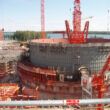Nuclear emergencies and the masters of improvisation
By Sonja Schmid, April 25, 2016
April 26 marks the 30th anniversary of the Chernobyl disaster, and those old enough to remember the event can recall the explosion, the evacuation, and the dread. But they rarely remember an immense milestone in the response to the disaster: the completion in November 1986 of a concrete encasement of Chernobyl's reactor number four. Workers drawn from all across the Soviet Union built this "sarcophagus" under extreme radiological conditions, on the ruins of the destroyed reactor. They used unimaginable amounts of concrete—and a great deal of imagination. This concrete mausoleum has held up, with some assistance, for 30 years now. (A larger containment structure that will fit over the existing sarcophagus is now being built.)
Over the years, as the ranks of those who responded to Chernobyl have thinned, new generations of nuclear professionals have been trained to prevent another disaster. Their training has emphasized "safety culture." This, along with "inherently safe designs," was going to guarantee an accident-free nuclear future. For a while, it seemed as if the world was on the verge of forgetting forever what responding to a nuclear emergency really required. Then, in March 2011, multiple reactors at one of the world's largest nuclear power plants melted down as a consequence of a massive earthquake, a tsunami, and a sustained power outage.
As a student of the Soviet nuclear power program and the Chernobyl disaster, it was painful for me to watch the blame game that played out immediately after Fukushima. Almost to the letter, the Chernobyl "script" was followed. First, the plant's operators were blamed. Then the reactor design was at fault. Finally, it was the turn of the national nuclear regulatory structure. "Culture," of course, received a great deal of blame as well.
But while Chernobyl could ultimately be dismissed as a Soviet-made disaster that "could never happen here"—wherever "here" happened to be—Fukushima has not allowed such steadfast denial. Indeed, Fukushima has proved the death knell for a nuclear safety philosophy that focused exclusively on preventing accidents. Disaster preparedness and response were given scant attention in the years between Chernobyl and Fukushima, but now they have been added to the vocabulary of the world's nuclear industries. Curiously, however, this shift is only partial. Disaster prevention retains the greatest emphasis; preparedness is sometimes treated adequately; but resources (and imagination) devoted to actual response strategies remain limited.
The "lessons learned" from Fukushima—and new reports on these lessons continue to be published—focus predominantly on technical and legal fixes, organizational reform, and liability concerns. In the United States, the Nuclear Regulatory Commission responded to Fukushima by overhauling its rules and guidelines for accident prevention, preparedness, and response. The US nuclear industry, meanwhile, implemented "FLEX," a program designed to provide nuclear reactors in distress with hardware such as extra pumps and generators, both on site and stored at regional centers. In Europe, power reactors were subjected to "stress tests" after Fukushima, and these tests sparked conversation among nations hosting nuclear power reactors about harmonizing, if only loosely, national regulations concerning natural (and other) hazards to nuclear power plants.
Steps such as these go in the right direction. But emphasizing prevention and preparedness over response ignores a simple fact: Nuclear disasters tend to exceed people's worst expectations. There is a good reason that the nuclear industry refers to disasters as "beyond design-basis accidents"—only a limited number of scenarios can be anticipated and prepared for. Disasters, therefore, require the development of creative, skill-based, and team-based response strategies (along with strenuous efforts to avoid disasters entirely).
Training for emergency responders in general tends to emphasize flexibility and imagination, with a premium placed on performing quick assessments and triage in unprecedented situations. But in nuclear emergency response training, the situation is different. The nuclear industry seems deeply troubled by using human imagination to address situations that go "beyond the checklist." In Europe and the United States, at least—I can't speak for the entire world—the nuclear industry seems hung up on the idea of control. There is a plan for every conceivable situation. Should plans fail, there are more plans. Staff are trained to follow procedures and execute instructions. If they don't, that's always bad.
Such an approach, as documented by the anthropologist Constance Perin, fundamentally fails to acknowledge the messiness of operating imperfect, real-world technologies (and all technologies are imperfect). Worse yet, it incapacitates an aspect of creativity that, though it's more often associated with jazz, can be tremendously important in nuclear emergencies: improvisation. In music, improvisation calls to mind wild, random, and perhaps solitary acts. But if emphasized in training for nuclear emergencies, the metaphor of improvisation can help prepare responders to pursue skill-based, team-oriented, and highly organized actions under challenging conditions.
In any disaster, improvisation occurs. It happened at Chernobyl, even if creative imagination was thoroughly expunged from all written reports. Improvisation happened at Fukushima, and in fact a lot more improvisation will be necessary if the Fukushima disaster is ever to "end." It is tempting to remember creative action only when it fails. Making this mistake locks in a mindset of control and controllability. Any such mindset will be exploded—yet again—by the next nuclear emergency.
Topics: Nuclear Energy
Share: [addthis tool="addthis_inline_share_toolbox"]














